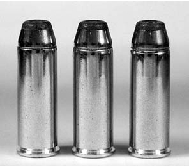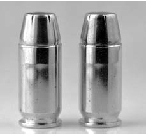Crimping
Crimping is the final reloading operation applied to either rifle or handgun cartridges. Reloading for most straight-wall cases calls for “belling” or expanding the case mouth to accept the bullet. In its most basic form, crimping is simply a “turning in” of the case mouth to remove the flare left by the belling operation. There are several different styles of crimp, with all having virtually the same goal; increased functional reliability. Depending on the type of cartridge and firearm being used, there are particular crimps that are appropriate, and certain styles that should be avoided. Making a proper decision as to which type of crimp should be used requires some understanding of bullet design, and the nature of the crimp involved. While there are several different styles or types of crimps, most will fall into one of two categories; a roll crimp, or a taper crimp. Throughout the rest of this discussion, bear in mind the fact that not all cartridges will require a crimp of any kind. For those cartridges which can be loaded without resorting to a crimp, we recommend omitting this step altogether.
The roll crimp is the most commonly seen style for revolver cartridges. As the name implies, the roll crimp entails forming a slight radius at the case mouth by pressing it inward against the bullet. Most bullets intended for use in revolver cartridges have a cannelure, or crimping groove impressed into the bearing surface. Two good examples of this are Sierra’s .45 caliber 185 grain JHP, and 240 grain JHC. The 185 grain JHP is designed for use in the .45 ACP cartridge and does not have a cannelure, as it is intended to be taper

These three cartridges show varying degrees of crimp. They are (from left to right) a slight or mild crimp, a good firm crimp, and too much crimp. The center example will be correct for most applications.
crimped. The 240 grain JHC, on the other hand, is designed for the .45 Colt revolver cartridge. It has a properly located cannelure and is intended to be roll crimped. It must be clearly understood that a cannelure is essential to obtain good results with a roll crimp. Remember, bullets that do not have a cannelure but need to be crimped should be given a taper crimp.
Taper crimping is the best choice for any firearm which headspaces on the case mouth. Cartridges intended for use in self-loading pistols, such as the .45 ACP, should never be given any type of crimp other than a taper crimp. Because of the method of headspacing on the case mouth, a slight ledge must be left to provide positive positioning of a chambered round.

An example of an improper type of crimp. These .45 ACP cartridges, intended for use in a semi-automatic pistol, have been given a roll crimp. Ammunition which head-spaces on the case mouth should be taper crimped only; roll crimps are best reserved for the rimmed cases commonly used in revolvers.
On these cases, the use of a roll crimp will result in poor ignition, unreliable functioning, and reduced accuracy. Few bullets designed for autos have cannelures, limiting the amount (and type) of crimp that may be applied. On any bullet, if the crimp being applied is heavy enough to cause any visible deformation, you are over crimping! Over doing the crimping reduces accuracy, so we strongly recommend using only the degree of crimp required for your particular loading application.
Regardless of which type of case a crimp is applied, one of the primary reasons for crimping remains the same; to increase neck tension, thereby ensuring proper powder ignition. In many cartridges, such as the .357 and .44 Magnums, large charges of slow-burning powders like H110 and Winchester 296 require firm initial resistance to the bullet’s movement. This building pressure aids in giving complete combustion, enhancing accuracy and shot to shot uniformity.
Despite the mechanical similarities of the differing styles of crimps, understand that the reasons for crimping varies considerably from one gun type to another. Hard-kicking revolvers, for example, require crimping to prevent the bullets from being pulled out of the case under recoil. In extreme cases this may result in the bullets actually protruding out the front of the cylinder, locking it up and effectively rendering the gun useless. A firm taper crimp on ammunition intended for use in an autoloading firearm is intended to do exactly the opposite; to prevent the bullet from being forced deeper into the case during the feeding cycle. It also serves to ensure reliable feeding by eliminating the sharp edge of the case mouth. Rifles having tubular magazines, such as the Winchester Model 94, also require bullets to be firmly crimped to prevent their being forced back into the case under recoil. Neck tension alone should be enough to prevent this from occurring, without resorting to excessive crimping. We regard this as a poor solution to an easily cured problem. Still, many reloaders do attempt to increase neck tension through the use of a tight taper crimp, with varying degrees of success.
Most manufacturers offer seating dies with built-in crimpers, particularly for those cartridges that predominantly utilize the roll crimp. Despite this, we continue to recommend that seating and crimping be done in separate operations. This can be easily accomplished in a single stage press by raising the seating die body enough that the case is not crimped at all when the press is at the top of the stroke. Adjust the seating stem to seat the bullet at the proper OAL, and seat your bullets without any crimp. When this is done, raise the seating stem to the top of its range, or better yet, remove it completely. With the ram at the top of its stroke, and a loaded cartridge in the shell holder, loosen the lock ring on the die and lower the body down to until you feel it contact the case mouth. Lower the ram, and adjust the die body down approximately 1/4 of a turn. Run the cartridge back through the die, and examine the crimp that has now been applied. If more crimp is called for, lower the ram, and adjust the die body down another 1/8 of a turn. Run the cartridge back through the die, and re-examine the crimp. Continue this process until the crimp is correct. Once the proper adjustment is attained, tighten the lock ring, and crimp the rest of your cartridges.
Final Inspection/Record Keeping
After the bullet has been seated, the round should be given a thorough final inspection before packaging. Cartridges having defects such as collapsed case mouths, crushed, high or inverted primers should be safely discarded, or broken down and the salvageable components reused. All traces of lubricant must be removed, if this was not done after resizing. The individual rounds may also be run through a cartridge gage at this point, to assure that it will feed and chamber reliably.
Ammunition may be stored in the original factory packaging, but it is best kept in the molded plastic boxes such as those made by MTM. Ammunition stored this way should ALWAYS be labeled with the pertinent information concerning the cartridge, the date it was loaded, components used, charge weights, velocity, etc.. This makes it easy to reproduce the load at a later date. Be sure to include any other information pertaining to this lot of ammunition that may be of use later. Sierra Bullets come boxed with adhesive labels made specifically for this purpose that are ideally suited to the task.
Remember, no handloader ever kept records that were too complete!
